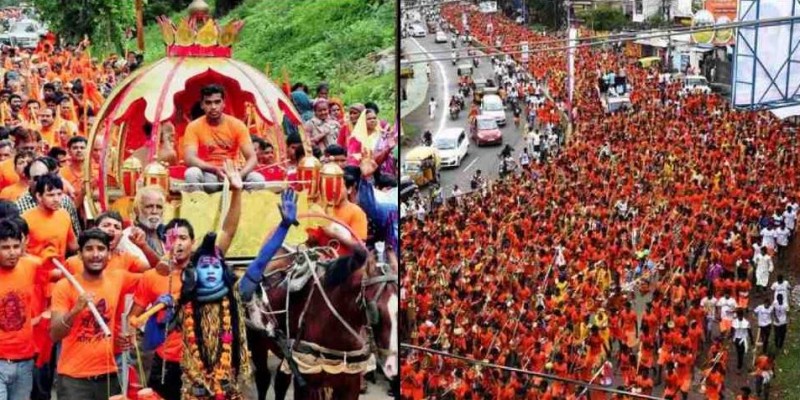
Kanwar Yatra is (how to do kanwar yatra) an annual pilgrimage celebrated by millions of Hindu devotees in India, signifying a deeply spiritual event. During the Yatra, devotees embark on journeys to their hometowns or nearby temples, carrying sacred water from the holy River Ganga. This age-old tradition has evolved into a grand religious spectacle, reflecting the unwavering faith and devotion of the participants. Today, we explore the origin (how to do kanwar yatra), history, and significance of Kanwar Yatra.
Origin and History:
As per the Shiva Purana, the churning of the cosmic ocean (samudra manthan) occurred during the month of Sawan. During this churning, fourteen types of gems emerged along with the deadly poison, halahal. To save the world from this lethal poison, Lord Shiva drank it, and it got stored in his throat, causing immense discomfort. In an attempt to alleviate the pain, the devotee Ravana offered Ganges water to Lord Shiva at Pura Mahadev in Baghpat. This event marked the inception of the Kanwar Yatra.
Kanwar Yatra Time and Route:
Kanwar Yatra takes place during the auspicious month of Shravan, usually falling between July and August. It is predominantly observed in the northern states of India, particularly Uttar Pradesh, Uttarakhand, Bihar, and Jharkhand. The pilgrimage often commences from significant cities like Haridwar, Prayagraj (Allahabad), and Varanasi. Devotees often traverse long distances barefoot, while some carry Kanwars (wooden or metal poles with two pots hanging on either end) on their shoulders as a gesture of reverence.
Significance and Rituals:
Kanwar Yatra holds profound significance for devotees, who view it as an opportunity to purify their souls and seek blessings from Lord Shiva. Carrying the sacred water symbolizes surrendering one's ego and humbling oneself before the divine. The participants believe that their sincere involvement in the Yatra can absolve them of sins and lead them towards moksha (liberation from the cycle of birth and death). Throughout the journey, devotees adhere to strict discipline, following a simple lifestyle by abstaining from non-vegetarian food, alcohol, and other indulgences. They engage in singing bhajans (devotional songs) and offering prayers at temples dedicated to Lord Shiva. The Yatra culminates with devotees performing abhishek (ritual bathing) of Lord Shiva's lingam using the holy water from the Ganges, expressing their devotion and gratitude.
Kanwar Yatra (how to do kanwar yatra) is much more than a mere pilgrimage; it represents the celebration of faith, devotion, and unity among millions of Hindus. The Yatra exemplifies the unyielding faith of the devotees and the deep-rooted cultural and spiritual heritage of India. As time progresses, the Kanwar Yatra incorporates modern transportation and technology, yet its essence remains unchanged – a reverent journey undertaken with unwavering devotion to Lord Shiva. This ancient tradition continues to radiate spiritual fervor, attracting countless pilgrims and retaining its prestige as a cherished event in India's religious landscape.
Muharram 2023: Jammu govt postpones ‘Ashura’ holiday; See new date
Sindhi Religion: A Journey of Cultural and Spiritual Traditions
If you are going on the Kailash Mansarovar Yatra, do not forget to visit these places as well